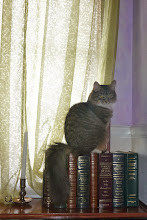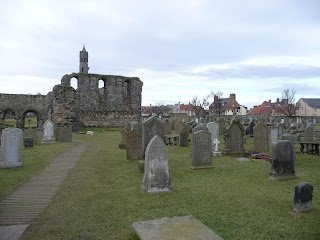I'm baaaack! I've had many adventures in the past (ouch--was it really a month and a half?), and enough photographs to wallpaper Versailles. Here we have the beginning of my adventures: Oxford!
Oxford is amazing. I'm even more in love with it than Cambridge, and I hardly thought that possible. It has a much more
consistently older feel than Cambridge. Cambridge has very old buildings mixed with very modern ones. Oxford blends the two together much more nicely. Furthermore, Oxford caters to the liberal arts majors (like me!), whereas Cambridge focuses more on mathematics and sciences.
Oxford is comprised of 38 separate colleges, and still operates under a (slightly modified and updated) medieval tutorial system. In other words, students mostly get one-on-one time with their advisers rather than sitting in lecture halls with 50 to 100 of their best friends.
Oxford is the oldest surviving university in the English-speaking world. Teaching began in the 1000s, but it didn't blossom until 1167, when King Henry II banned English students from attending the University of Paris. Some riots broke out between the students and the townies in 1209 and several of the students fled to Cambridge, where they proceeded to set up Cambridge University.

St. John's College is the oldest college, and has a propensity for spitting out future Prime Ministers. Twenty-five prime ministers have graduated from Oxford to date, along with thirty international leaders, twenty Archbishops of Canterbury, fifty Olympic medalists, and twelve saints. (N.B.--I have no idea if this is a picture of St. John's College or not; the photos got a bit jumbled. I stuck this one in the blog because it was pretty.)

This is a photo of one of the courtyards of King's College. It is here that J.R.R. Tolkien first began writing the hobbit. He and his buddy, C.S. Lewis, along with a group of literary friends who called themselves the Inklings, would go down to the Eagle and Child pub, get absolutely wasted, and concoct stories together. Then during the daytime, when they were sobered up and not teaching students, they would write out the ideas they'd hatched the night before.

This is the Radcliffe Camera, part of the Bodleian Library. The Bodleian Library has at least one copy of every book ever printed in the UK. Some of the books are so old that they are chained to the walls for security purposes. And as you walk across Radcliffe Square, tread carefully--the majority of the library is underground!

Here is Christ Church College, popularly known for Alice and Wonderland and Harry Potter. Oxford has a rather impressive register of names of famous authors who have attended the university, including Tolkien, C.S. Lewis, Lewis Carroll, T.S. Eliot, John Donne, Percy Shelley, Robert Graves, and Samuel Johnson, to name just a few. T.E. Lawrence attended Jesus College as an undergraduate and All Souls as a postgrad, and it was there that he wrote the Seven Pillars of Wisdom.

This is one of the outer courtyards of Christ Church College. It was here that Alice Liddell, the daughter of the Dean of Christ Church College, would play with her cat Dinah.

Her father's friend and colleague, Rev. Charles Lutwidge Dodgson, a.k.a. Lewis Carroll, would often take Alice and her two older sisters on outings when their parents were busy.

The dining hall at Christ Church College. At the far left end, near the professors' table, is a small doorway that the dean of Christ Church college would disappear through after the meal was over. This way, the dean could leave dinner early to attend to business (especially when he was late for a very important date) without having to wade through the long rows of students. Alice Liddell's father, when he was dean, referred to the door as the "rabbit-hole."

The contents of that rabbit hole are looking awfully scholarly.
But wait! I've seen that dining hall before! Here it is...

And there it is again! (Give or take a few candles)

Yep. Christ Church College dining hall served as the inspiration for the Hogwarts dining hall in the Harry Potter movies. They didn't use the actual dining hall (it was too dark, only had three tables instead of four, and the ceiling looked way too solid), but they modeled the studio one after it.
Here's another familiar sight:

Miss M on the staircase...

McGonagall on the staircase, waiting to greet the soon-to-be-sorted first years. Maybe my photo would look more impressive if I had the hat.
Now, it's all well and good to write that Harry Potter has a lightning-shaped scar on his forehead and not go into any further detail than that. It leaves something to the reader's imagination. But that doesn't work so well for Hollywood, when the makeup mistress on the movie set is pestering the author about what
exact sort of lightning bolt it is. Is it a crackling one? A very zig-zaggy one? What sort of eyeliner-pencil design should be scratched onto Daniel Radcliffe's forehead?
Well, to tell the truth, J.K. Rowling wasn't all that sure herself. What
did the lightning bolt scar look like,
precisely? She stewed, pondered, tossed and turned over the question, but still had no answer, and the makeup mistress was getting rather antsy. So J.K. Rowling popped down to Oxford to see a friend for the weekend and maybe get some inspiration. There she was, wandering about Oxford, racking her brain for a design, when she looked down at her feet and saw...

the perfect lightning bolt, etched into the stones outside the Sheldonian Theatre. Presto!

Now, if only I can magic my way into Oxford's graduate program...































